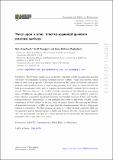Twice upon a time: timelike-separated quantum extremal surfaces
Author(s)
Engelhardt, Netta; Penington, Geoff; Shahbazi-Moghaddam, Arvin
Download13130_2024_Article_22542.pdf (2.194Mb)
Publisher with Creative Commons License
Publisher with Creative Commons License
Creative Commons Attribution
Terms of use
Metadata
Show full item recordAbstract
The Python’s Lunch conjecture for the complexity of bulk reconstruction involves two types of nonminimal quantum extremal surfaces (QESs): bulges and throats, which differ by their local properties. The conjecture relies on the connection between bulk spatial geometry and quantum codes: a constricting geometry from bulge to throat encodes the bulk state nonisometrically, and so requires an exponentially complex Grover search to decode. However, thus far, the Python’s Lunch conjecture is only defined for spacetimes where all QESs are spacelike-separated from one another. Here we explicitly construct (time-reflection symmetric) spacetimes featuring both timelike-separated bulges and timelike-separated throats. Interestingly, all our examples also feature a third type of QES, locally resembling a de Sitter bifurcation surface, which we name a bounce. By analyzing the Hessian of generalized entropy at a QES, we argue that this classification into throats, bulges and bounces is exhaustive. We then propose an updated Python’s Lunch conjecture that can accommodate general timelike-separated QESs and bounces. Notably, our proposal suggests that the gravitational analogue of a tensor network is not necessarily the time-reflection symmetric slice, even when one exists.
Date issued
2024-01-08Department
Massachusetts Institute of Technology. Center for Theoretical PhysicsPublisher
Springer Berlin Heidelberg
Citation
Journal of High Energy Physics. 2024 Jan 08;2024(1):33
Version: Final published version